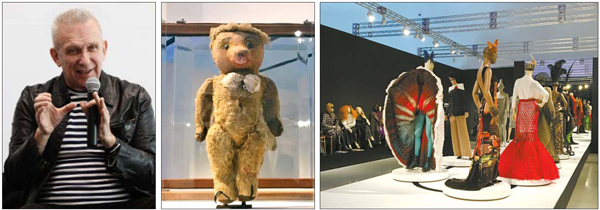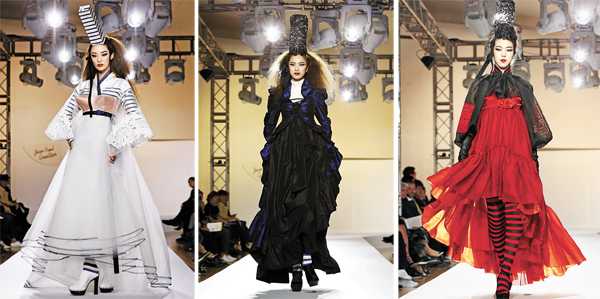Gaultier ends world tour in Seoul with hanbok

From left to right: Jean Paul Gaultier speaks at a press conference ahead of his first exhibition in Korea; the designer’s teddy bear Nana wears his iconic cone bra design; the exhibition ongoing at DDP includes a “Punk Cancan” section. [[HyUndai Card, YIM SEUNG-HYE]
Many of Gaultier’s followers ought to be quite immune by now to his avant-garde style clothes that always seem to demolish existing ideas. But when the French designer showed off his variation of hanbok, or Korean traditional dress, during his haute couture show March 25 at the Dongdaemun Design Plaza in central Seoul, the enfant terrible dealt yet another refreshing jolt, especially to Korean fashion aficionados.
His interpretation of hanbok managed to maintain the unique silhouette of the hanbok - a voluminous curvy skirt and a top that’s tight around bosom. But other than that, he transformed the traditional attire to look “very Gaultier,” according to the designer. For the top, Gaultier used see-through chiffon fabric on top of his iconic French fisherman white-and-blue stripes, the so-called Breton stripes. For the balloon-like lacy skirt, Gaultier made the front of the skirt to be shorter than the back, so that the model’s ankles adorned in stripey socks are exposed. Finally, another iconic design of Gaultier - the “cone bra,” which the designer created for Madonna in 1990 for her Blond Ambition Tour - completes the Gaultier-style hanbok look.
“I love to transform traditional designs in a ‘Gaultier way,’” the designer said, adding that it was very fun for him to try it on Korean traditional dress that’s “of course beautiful as it is.”
“I hope Koreans appreciate it,” said Gaultier. “I don’t know if you will wear it but I wanted to show me through this work to the Korean audience.”
Gaultier’s “From the Sidewalk to Catwalk” exhibition that has been touring around the world since 2011 came to Seoul for its final stop - yet its first stop in Asia - before heading back to the Montreal Museum of Fine Arts. The Seoul exhibition was organized as one of the events to mark the 130th anniversary of Korea-France diplomatic ties as well as the 21st chapter of Hyundai Card’s cultural patronage projects.
The exhibition is the first retrospective of the designer, showing over 150 haute couture as well as some ready-to-wear clothes he designed since his career began in 1976. A day before the exhibit began its three-month run on March 27, the designer held an haute couture fashion show especially for the Korean audience, showing off his interpretation of hanbok.
“My exhibition toured around 11 different cities for five years, yet I’ve never held a fashion show before the exhibition before,” said Gaultier. “It’s something special and unique I’ve organized for the Seoul exhibition, which is also my finale.”
After jumping into the fashion industry by designing a ready-to-wear collection in 1976, Gaultier soon plunged into haute couture, leading him to establish his own haute couture atelier in 1997.
“I haven’t done ready-to-wear collections for decades now,” Gaultier said, explaining why he’s been focusing on creating haute couture collections that require exquisite craftsmanship. “I started doing fashion because I fell in love with a film I watched about designing haute couture titled ‘Falbalas’ [1994]. Through the movie, I saw all the creativity and intensity of an atelier, and it was beautiful how designers create something beautiful while not thinking about merchandising or marketing. The film itself was a good school for me.”
The designer, who thinks outside the box, breaking stereotypes and boundaries, said he prefers creating haute couture because “I can do things that are unique, which I love. They are always a new adventure for me.”
Without a doubt, one of Gaultier’s most iconic designs is the cone bra that Madonna wore in 1990. According to the designer, he drew more than a thousand sketches to create the cone bra for the diva, but in fact she wasn’t his first model or his inspiration for this iconic design. When he was a young boy, Gaultier said his parents didn’t buy him a teddy bear because he was a boy. When he finally got his hands on a brown teddy bear named Nana, Gaultier says he began designing women’s clothes for the teddy, and one of his creations was a cone bra made with newspaper. Spending a lot of time with his grandmother, who used to own a beauty salon and work as a beauty consultant, Gaultier said he was charmed by her array of dresses, especially the corsets. And this became “the leitmotif” of his oeuvre, the designer says.

Gaultier organized a fashion show before his exhibition opened at DDP. The show featured most of the haute couture on display including his interpretation of hanbok, or Korean traditional dress, left. [HyUndai Card]
“There’s no such thing that defines what’s beautiful,” said Gaultier. “Everybody should be themselves rather than trying to be like an American or French.”
Gaultier said the best way to stay beautiful and unique is to “keep the tradition but at the same time have the eyes open on what’s happening around you and mix the tradition with new creation.”
Next, the “Odyssey” section surprises visitors with mannequins that smile, change their expressions and even speak. According to Jang Han-gyul, a docent at the exhibition, the animated mannequins were Gaultier’s only request for his world tour.
“For the world tour exhibition, Gaultier is said to have requested only one thing and that was not to make his exhibition look like a funeral,” said Jang. “He said his clothes are created to be worn rather than just to be displayed. So these animated mannequins were installed in order to make the exhibition lifelike and inspire vitality.” Here, visitors can also see an animated mannequin of Gaultier himself, wearing his iconic blue-and-white striped top, reciting the old French poem that became his inspiration for creating his striped designs.
The third “Skin Deep” section is where some visitors may have difficulty in deciding where to look. Most of the female mannequins here are wearing nude body suits that make them look naked, with certain parts decorated with beads to make them more realistic. According to the organizers, the human body has been the basis of Gaultier’s work and one of his many eclectic and impertinent sources of inspiration includes the human body and skin. He used the so-called “trompe-loeil,” or optical illusion effect, to create the skintight garments in stretch tulle, for example, displayed in this section.
As the designer who constantly strives to break down boundaries defining men and women, Gaultier was probably the first designer to show in his collection trousers for men that look like a long skirt in the front, back in 1985. When his male models walked down the runway wearing such garments, his VIP guests, such as fashion magazine editors, are said to have stormed out in the middle of the show.
While recalling this episode, Gaultier said, “Men, like most women, can feel like wearing something gorgeous,” adding that he doesn’t really “understand why masculine women are simply considered special while feminine men get ostracized.” Insisting that there shouldn’t be a distinction between the roles of men and women, Gaultier said there’s no distinction between what fabrics are for women and what are for men. At the exhibit, many of the men’s clothes on display use fabrics that are considered feminine such as lace. These clothes can be witnessed at the “Punk Cancan” section. Also on display are his designs that combine both the Parisian look and the Londoner look.
Gaultier is also known to treasure different cultures and is drawn to creating new an aesthetic in which a garment personifies the dialogue between different cultures and ethnicities. In the “Urban Jungle” section, Gaultier displays an array of hybrid fashion, including a “Gaultier-style” kimono, a Mongolian jacket, flamenco skirts, African masks and so on. The designer also loves to go into the jungle and get inspired by wildlife and animals. Some collections on view here include a dress made with crocodile leather as well as an anaconda dress that uses snake skin from top to bottom.
In the “Metropolis” section, Gaultier showcases the flamboyant world of fashion when it meets cinema, television, music and dance. Here are Gaultier’s costumes he designed for diverse performances, including the film “The Cook, the Thief His Wife and Her Lover” (1989) as well as the famous costumes for “The Fifth Element” (1997).
The final section displays an array of “Gaultier-style” wedding dresses. Gaultier still uses white lace gowns but has added his iconic designs to each of them. For example, one of the wedding dresses has a masculine look, using a warrior-like feather headdress and a pirate’s eye patch encrusted with precious stones, while an African mask gown screens the body like a shield.
Some of the other highlights of the exhibit include contemporary art photography and fashion photography showing original and several never-before-published prints by renowned artists including Andy Warhol, Cindy Sherman, Jean-Baptiste Mondino and so on. The exhibition runs until June 30. Admission is 15,000 won. For more information, go to www.superseries.kr.
BY YIM SEUNG-HYE [sharon@joongang.co.kr]










with the Korea JoongAng Daily
To write comments, please log in to one of the accounts.
Standards Board Policy (0/250자)